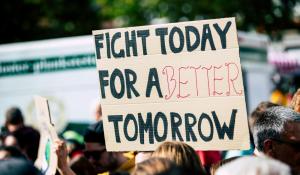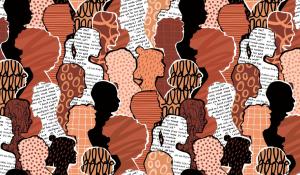
Climate change and the need for developing environmentally sustainable systems of business, food supplies, power production, and so forth, are issues that affect communities worldwide. Disabled people are particularly vulnerable to how climate change exacerbates inequitable access to resources like disaster relief, health care, and housing, yet disabled voices and perspectives are marginalized, if not outright ignored, in discussions shaping public policies and in implementing solutions. And under the current administration’s attacks on diversity, equity, and inclusion focused programs, disabled people face even higher barriers to access of critical resources and support.
Disability Culture Lab is the first nonprofit media and narrative lab created to shift the ways disability is commonly perceived and understood by an ableist society. In this interview, founder and director Meier Galblum Haigh shared their thoughts with Green America about common myths pitting the needs of disabled people against environmental sustainability, how disability communities are building climate resiliency, and why disability justice is an essential part of climate advocacy.
The following text has been edited for clarity.
Green America: Disabled people are twice as likely as non-disabled people to be harmed by the effects of climate change—we’ve seen this horribly reflected in the aftermath of recent disasters like the wildfires in Los Angeles, but U.S. sustainability policies often don’t prioritize the needs of disabled communities. What are some common misconceptions about the relationship between disability justice and environmental sustainability?
Meier Galblum Haigh: There is a myth that disability justice and environmental sustainability or climate change are at odds. That myth has been fueled by billionaire-friendly campaigns that pit accessibility devices against sustainability. In reality, climate justice, environmental justice, and disability justice are one fight: It’s the people vs. corporate greed.
Disabled people face regular harassment over access to basic life. It benefits fossil fuel companies and corporations to push a false narrative of “personal responsibility” environmentalism over public health and pollution regulations. That harassment extends to plastic straws, pre-cut vegetable packages, grocery delivery, and more. The result: Everything we need to survive becomes the target, rather than the disabling actions they take to get and stay rich.
Pollution, fossil fuel extraction and processing, and climate disasters like wildfires and super storms are all disabling. Disabled people are left behind in disaster planning and response, and it gets worse as the frequency and intensity of storms increases.
GA: How can we proactively disrupt these false choices pitting disability needs against environmental concerns in our advocacy?
Haigh: We need to remind folks who the real villains are: corporations who have made billions of dollars polluting our air, water, and climate—and [are] lying about it.
Disabled folks should be a core constituency in the climate movement, but the inaccessibility of most climate and environmental advocacy means so much power is left on the table. If we want to win in this fight of people vs. [corporate] power—we need all of us.
For too long, environmental justice and climate activists have practiced the same sacrifice zone politics of fossil fuel companies, picking and choosing which communities are worthy and which to leave out. But there is too much at stake. It’s time to make space for a new wave of organizing where we all get free together—because we can’t afford to leave power on the table.
GA: Community-led innovations are vital to a thriving green economy. What are some key insights that sustainability movements are missing by not integrating the lived expertise of disabled people from the start?
Haigh: First, we need an accessible Green New Deal. We need clean, accessible cities and towns across the U.S. that are walkable and rollable for all. That looks like protected bike lanes for power chairs and scooters and Deaf/hard of hearing cyclists—not just able-bodied cyclists. Folks want to see transit for all, not for some.
Second, we can’t pit people against people. Sustainability activists too often take the corporate bait and blame individuals—too often poor and disabled folks—for billionaires’ corporate greed. We should be going after fossil fuel companies and mega-retailers, not disabled folks’ straws. We should push car companies to make EVs, and politicians to build a better EV grid—not attack disabled parents who need food delivery to feed our families.
GA: Representation matters but even when disabled people are included in the decision-making process and policy implementation, what are some common pitfalls that can happen? What steps can we take to help the impact of proposed solutions align with their intentions?
Haigh: It’s important that we don’t tokenize. We need disabled representation that represents the needs of disability communities, not just one disabled person at one table.
We need accessible climate and environmental justice movements and organizations that ensure as many disabled people can participate at every level as possible. We don’t just need CART and ASL and wheelchair access—we need a commitment to radical inclusivity that puts disabled ideas and brilliance at every table. And we need funding for our organizations to join those tables.
GA: Information accessibility is just as important as accessing resources, especially at a moment when the spread of dis/misinformation through news and other media channels, as well as social networks, is a real danger. How have disabled folks been affected by dis/misinformation about issues like climate change, green economies, and sustainability movements?
Haigh: There is a huge dis/misinformation pipeline targeting the disability community online. Especially young disabled white men—just like other young white men across the country have been targeted by influencers who spread misogynistic, racist, and transphobic rhetoric. We need a lot more funding and a lot more research on where our folks are being targeted, how, and how to combat that dis/misinformation.
GA: The negative impacts of pesticides, microplastics, fossil fuels, monocropping, and other environmental issues compound the already considerable difficulties of existing in our ableist systems. What are some of the solutions and resources disabled communities have developed as a result that “green” movements should be learning from?
Haigh: One piece of disability community organizing that I think “green” movements should learn from is the practice of access—working to make all actions, events, aid, and anything else we do as accessible as possible to as many people as possible.
We include questions about access needs in event invitations, and shift resources to meet them. We post access information in advance—parking, stairs, food and allergy restrictions, distance, scent sensitivities, ASL, CART, etc. We try to meet people where they are at, rather than expecting people to meet us where we are.
Environmental injustice is disabling. Climate injustice is disabling. The reality is, just as “green” movements have fallen short on access, inclusion, and the embracing the power of disabled people, our government has fallen short as well. In response, many disability communities have developed tight-knit mutual aid networks to deal with the massive gaps in care infrastructure. Other movements would do well to follow suit.
We need organizing, mutual aid, and a lot of cultural change work to get us through what’s coming. Let’s make it happen. Together.
To learn more about Disability Culture Lab’s work, visit disabilityculturelab.org






